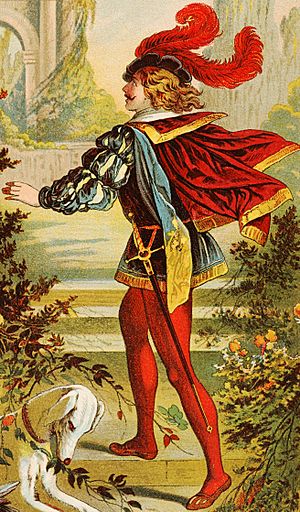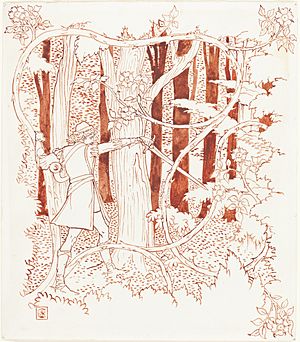Prince Charming facts for kids

Prince Charming is a well-known character in many fairy tales. He is usually a hero who comes to save a princess or a young woman in trouble. Often, he has to go on a special journey or quest to free her from a bad spell.
You can find a "Prince Charming" type of hero in famous stories like "Snow White", "Sleeping Beauty", and "Cinderella". Even if these heroes don't have the exact name "Prince Charming" in their original tales, they fit the description. These princes are often shown as handsome and romantic. They are important because they help the main female character achieve her happy ending. The term "Prince Charming" is also used in real life to describe an ideal person someone hopes to marry.
Contents
The History of the Name

The idea of "Prince Charming" has a long history. One of the first times a similar idea appeared was in Charles Perrault's version of Sleeping Beauty. This story was published way back in 1697.
Perrault's Sleeping Beauty
In Perrault's Sleeping Beauty, when the princess wakes up, she asks, "Are you my prince? You've kept me waiting a long time." The story then says, "The prince charmed by her words... did not know how to express his joy." Some people think this part might have inspired the name "Prince Charming." It's interesting because here, the prince is the one who is "charmed" (meaning delighted), not necessarily the one who is "charming" (meaning delightful).
Other Early Uses
In the 1600s, another writer named Madame d'Aulnoy wrote fairy tales. In her story The Story of Pretty Goldilocks, the hero was named Avenant, which means "Fine" or "Beautiful" in French. In another tale, The Blue Bird, the hero was called Le roi Charmant, meaning "The Charming King."
When Andrew Lang later retold these stories in English, he called the hero in Goldilocks "Charming." He called the hero in The Blue Bird "King Charming." Even though these characters weren't always princes or even royal, these stories helped popularize the idea of a "charming" hero.
Disney's Influence
The idea of Prince Charming became even more famous with Disney movies. In the early animated film Snow White and the Seven Dwarfs (1937), Snow White tells the dwarfs about her prince. She says, "Anyone could see that the prince was charming, the only one for me." Even though he isn't officially called "Prince Charming" in the movie, the description stuck.
Later, when Disney animators were creating the villain Gaston for Beauty and the Beast, they wanted him to be a twisted version of the handsome Prince Charming character. They made him look like a very handsome soap opera actor to create this effect.
Names in Other Languages
In some other languages, the name for this character is different. For example, in Spanish and Italian, he is often called the "Blue Prince." In Portuguese, he is sometimes called "Charmed Prince" (Príncipe Encantado). This is a bit of a translation mistake, but it actually ends up being closer to the original meaning in Perrault's Sleeping Beauty story.
See also
 In Spanish: Príncipe azul para niños
In Spanish: Príncipe azul para niños

